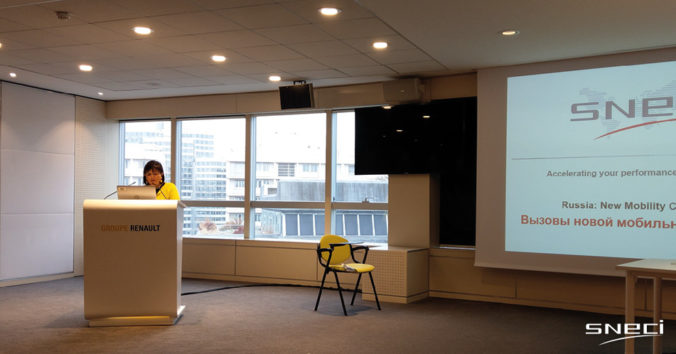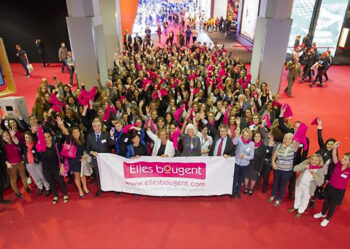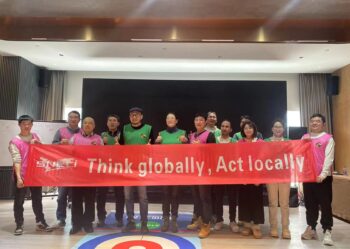Challenges of New Mobility in Russia

When we talk about New Mobility in Russia, we should keep in mind not only the current state of its automotive industry or the cultural and economic differences between Russia and Europe but also its potential and the role of government in the development of New Mobility.
This is why, on October 22, Renault organized a roundtable on New Mobility in Russia and Moscow’s Investment Potential with the participation of the Government of Moscow, Nicolas Maure, Vice President of Eurasia Region at Renault, and other speakers including Isabelle Bailly, Chairman of SNECI.
The development of New Mobility in Russia is currently facing several challenges that could be generally divided into two main categories: Technical and Economic challenges, and Cultural and Sociological challenges.
TECHNICAL AND ECONOMIC CHALLENGES
New Products and Technologies
New mobility implies new products and technologies. Think about electric vehicles, hydrogen vehicles, hybrid vehicles, car-sharing, robot-cars… All of this requires not only a strong and well-funded R&D but also a proper infrastructure and new government regulations.
Although electric vehicles are not that popular (only 94 electric cars were sold this year), car-sharing is well established in Russia. For instance, Russia is the first market of Blablacar with more than 15 million users. Even Yandex, the largest search engine and Technology Corporation in Russia, has launched its own car-sharing service: Yandex Drive.
New Actors
Today, there are not only traditional OEMs on the market anymore. New actors are leading New Mobility in Russia. Such giant US players as Tesla and Apple alongside more than 20 new Chinese EV makers compete with traditional OEMs on the electric vehicle market nowadays. Not taking into account all the car-share providers like Uber and Blablacar or even the Russian Yandex Drive and Belkacar!
New Suppliers
New Mobility also means new suppliers that no longer come exclusively from the automotive industry. Software and electronics suppliers, uncommon for traditional mobility, are needed to build connected and electric vehicles of today.
The Current Level of Russian Automotive Industry
“Four main points should be mentioned about the current level of Russian automotive industry when talking about the opportunities in New Mobility in Russia”, states Isabelle Bailly. “First, the enormous amount of OEMs that leads to underutilized capabilities. Second, the increasing power of governments and clusters. Thirdly, local suppliers of car parts are still developing in terms of quality and project management and cannot export or deliver under the high requirements of global OEMs. Last but not least, the slow market growth results in the reluctance of international investors”. Despite the sales growth in the Russian automotive market projected at the level of 12-15% in 2018, there is still only 300 cars per 1000 inhabitants in Russia, a rather low level compared to Europe or USA.
Financing of Investments
The financing of investments in New Mobility in Russia by private individuals locally is impossible due to an insufficient amount of local actors with ample financial resources. The possibility for the Russian state to support the funding of New Mobility and those of the traditional auto industry at the same time is also debatable. Finally, the Decree 166 and 566 will make it nearly impossible to supply from outside of Russia.
Meanwhile, the Russian investment climate is improving rapidly with the development of technoparks and special tax regimes, mainly in Moscow, an obvious leader for investment in Russia. Only over the past five years, investments in fixed assets increased by 55.6%, in comparable prices against 2010. Moreover, a significant amount of funds is being spent on transport and communications development (8% of the total investments in fixed assets in 2016). Russia has also occupied the 40th position in the World Bank’s Doing Business rating in 2017, improving it by 11 points in one year only.
CULTURAL AND SOCIAL CHALLENGES
Consumer preferences have a great impact on the automotive market trends. In Russia, the vehicle is a synonym to Status and Individual Freedom. Therefore, Russians may not be willing to abandon these recent gains to be under the control of algorithms and foreign countries.
Furthermore, a lot of countries face consumer hesitancy towards New Mobility. For example, Europe has shown a very low market uptake of alternatively-powered vehicles in last years (market share grew by only 0.9% points between 2015 and 2017).
Finally, the drastic change in professional profiles that are needed between traditional and new mobility can lead to a severe risk of social consequences. To reduce this risk, the Russian government should encourage the development of transferable skills in electronics between automotive, defence, and space. Such exchange of skills will also help Russia to raise up to the important players of the automotive industry of today, given its know-how in defence and space.








